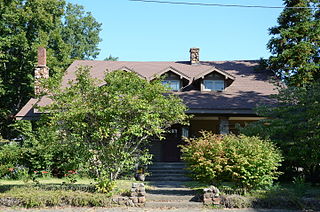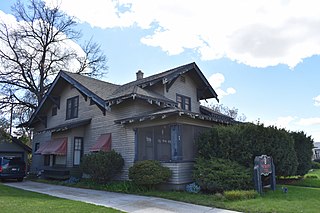
The South Charter Street Historic District is a nationally designated historic district in Monticello, Piatt County, Illinois. The residential historic district includes all of South Charter Street from Marion Street to Sage Drive; it contains 73 buildings, 59 of which are considered contributing to its historic character. The houses display a variety of architectural styles and vernacular designs popular in the late 19th and early 20th centuries. The district was added to the National Register of Historic Places on January 17, 2002.

The Thomas Gould Jr. House is a historic house located at 402 Lynn Drive in Ventura, California. Architect Henry Mather Greene designed the American Craftsman style California bungalow, which was built in 1924. The house is considered one of the best examples of Henry Greene's independent work; most of his other designs were created alongside his brother Charles as Greene & Greene. The two-story house has a wood frame and redwood siding and window casings. The gable roof features truncated ends and a small gable on the front side which resembles a dormer. The house's interior decorations include ceiling moldings, a leaded glass china cabinet, and a carved mirror, the latter being the only piece of furniture designed by Greene himself.

The Charles W. Noyes House is an historic single-family bungalow located at 271 Chestnut Street in the village of West Newton in Newton, Massachusetts. Designed in the American Craftsman style of architecture by Boston-based architect Hubert G. Ripley of Ripley & Le Boutillier, it was built in 1914. It is 1+1⁄2 stories in height, with a broad shallow-pitched clipped-gable roof and stuccoed exterior. The street-facing facade has banks of small-paned windows at each level. Charles W. Noyes, the owner, was a lawyer.

The Farrell Houses are a group of four houses on South Louisiana Street in Little Rock, Arkansas. All four houses are architecturally significant Bungalow/Craftsman buildings designed by the noted Arkansas architect Charles L. Thompson as rental properties for A.E. Farrell, a local businessman, and built in 1914. All were individually listed on the National Register of Historic Places for their association with Thompson. All four are also contributing properties to the Governor's Mansion Historic District, to which they were added in a 1988 enlargement of the district boundaries.

The W. C. Baker House is an airplane bungalow located at 301 E. Commerce in the city of Altus, Oklahoma. The house was built in 1917 for the sister of William Clarence Baker; however, Baker bought the house shortly afterward. Baker owned a local machine shop and cotton gin, and he served on Altus' original city council. The house has a typical airplane bungalow plan with a small second story above a low, multi-component first-floor roof, a design reminiscent of an airplane's cockpit. The house's design also includes many characteristic features of the Craftsman style, including overhanging eaves and exposed rafter tails. The porch features battered columns supporting its roof and decorative stickwork in its gable, both of which are typical Craftsman elements.

The Oak Circle Historic District is a historic district in Wilmette, Illinois, United States. The district covers 2.6 acres (0.011 km2) and includes twenty-two contributing properties and four non-contributing properties, all located along Oak Circle. It primarily consists of fifteen single-family homes representative of the Prairie School and Craftsman styles of architecture. The Oak Circle Historic District was added to the National Register of Historic Places on June 21, 2001; it was the first historic district to be designated in Wilmette.

The Deener House is a historic house at 310 East Center Street in Searcy, Arkansas. It is a 1+1⁄2-story Bungalow/Craftsman style house that was designed by noted Arkansas architect Charles L. Thompson and built in 1912. It has the low-slung appearance typical of the Bungalow style, with a side gable roof that extends across its full-width front porch, where it is supported by fieldstone piers, and shows exposed rafters. Three small gable-roof dormers are closely spaced near the center of the otherwise expansive roof.

The Ingersoll Place Plat Historic District is located in Des Moines, Iowa, United States. It has been listed on the National Register of Historic Places since 2000. The historic significance of the district is based on the concentration of bungalows and square houses as well as a mix of subtypes.

The Middlesex Plat Historic District is located in Des Moines, Iowa, United States. It was an upper-middle-class neighborhood of two-story square houses and bungalows that were built from 1910 to 1923. The district has been listed on the National Register of Historic Places since 2000. It is part of The Bungalow and Square House--Des Moines Residential Growth and Development MPS.

Sara-Thel Court is a bungalow court located at 618-630 S. Marengo Ave. in Pasadena, California. The court includes seven buildings arranged around a central walkway; six of the buildings are single-family units, while a double unit is located at the end of the walkway. Built in 1921, the court was designed by Jas. Humphreys. The houses were mainly designed in the American Craftsman style and feature gable roofs with shallow slopes and exposed rafters; the moldings on the homes were inspired by the Colonial Revival style.

The Ed M. Stotlar House is a historic house located at 1304 W. Main St. in Marion, Illinois. The house was built in 1914-15 for Southern Illinois lumber salesman Ed M. Stotlar and his family. Stotlar was also the longtime president of the Marion Library Board and a prominent art and book collector. Architect George William Ashby designed the home in a blend of the American Craftsman and Prairie School styles. The house features connected double-hung windows and a gable roof with overhanging eaves and exposed rafter tails, characteristic features of the Craftsman style. Its Prairie School influences include its art glass windows and horizontal ribbons of brick near the top of the first floor.

Settlemyer House, also known as the Bailey House, is a historic home located at Gaffney, Cherokee County, South Carolina. It was built in 1922, and consists of a large two-story central block with one-story wings. It features a low gable roof with flared rafter tails and a porte-cochere with flared eaves and large random course stone and concrete piers. It is an example of the Japanese influenced Bungalow design, in the American Craftsman tradition, of the early 1920s. Also on the property is an original two-story frame garage and a random course stone and concrete wall in front of the house.

The J. M. McClintock House is a historic house at 43 Magnolia Street in Marianna, Arkansas. It is a 1+1⁄2-story wood-frame structure, designed by Charles L. Thompson and built in 1912, whose Craftsman/Bungalow styling is in marked contrast to the W.S. McClintock House, a Colonial Revival structure designed by Thompson for another member of the McClintock family and built the same year. This house has the broad sweeping roof line with exposed rafters covering a porch supported by brick piers and paired wooden box posts on either side of the centered stair. A dormer with clipped-gable roof is centered above the entry.

John Marion Galloway House is a historic home located at Greensboro, Guilford County, North Carolina. It was designed by noted architect Harry Barton and built in 1919. It is a three-story, rectangular dwelling with Tudor Revival and Bungalow / American Craftsman style design elements. It has a veneer of random-coursed granite with half-timbered gable ends, gable-roofed dormers, and a red tile roof. Also on the property is a contributing two-story double garage which once included servants' quarters.

O. Arthur Kirkman House and Outbuildings is a historic urban estate located at High Point, Guilford County, North Carolina. Its main house, built in 1913, is a two-story brick dwelling with design elements from the Colonial Revival, Tudor Revival, and Bungalow / American Craftsman. It has a steep pitched gable roof, wide eaves with decorative brackets, and stained glass windows. In addition, the property displays a contributing detached, single car garage (1913), a brick dog house (1913), a depot (1916-1917), an office (pre-1913), and the former Blair School.

Carlos and Anne Recker House, also known as the Recker-Aley-Ajamie House, is a historic home located at Indianapolis, Marion County, Indiana. It was built in 1908, and is a 1+1⁄2-story, Bungalow / American Craftsman style frame dwelling. It has a steeply pitched side-gable roof with dormers. The house was built to plans prepared by Gustav Stickley through his Craftsman Home Builder's Club.

George Philip Meier House, also known as Tuckaway, is a historic home located at Indianapolis, Indiana. It was built in 1907, and is a two-story, Bungalow / American Craftsman style frame dwelling clad in cedar clapboard. The second story was added in 1912. It has a front gable roof and features a full width front porch and scrolled brackets on the overhanging eaves.

The Roscoe Conklin Linder House in Hartwell, Georgia is a Craftsman bungalow which was built in 1917. It was listed on the National Register of Historic Places in 1986.

The E.F. Hunt House in Meridian, Idaho, USA, is a 1½-story Craftsman bungalow designed by Tourtellotte & Hummel and constructed in 1913. The house has an unusual roof design, with a lateral ridgebeam extending beyond left and right gables, hip roofs on either side of a prominent, front facing gable, and a lower hip roof above a cross facade porch. Double notch rafters project from lateral eaves and from cantilevered window bays with shed roofs below the side facing gables. Narrow clapboard siding covers exterior walls. The front porch is supported by square posts with geometric, dropped caps. Tourtellotte & Hummel had used the square post decorations in other Bungalow houses, and a more elaborate example is found on the porch of the William Sidenfaden House (1912) in Boise. The house was added to the National Register of Historic Places in 1982.

The Fred Tunturi House is a historic residence located in Portland, Oregon, United States. Built in 1922, it is the only well-preserved Craftsman bungalow in the Walnut Park district of Portland that exhibits two classic features of the bungalow type: a full-width porch and a low, continuous, gable roof.






















